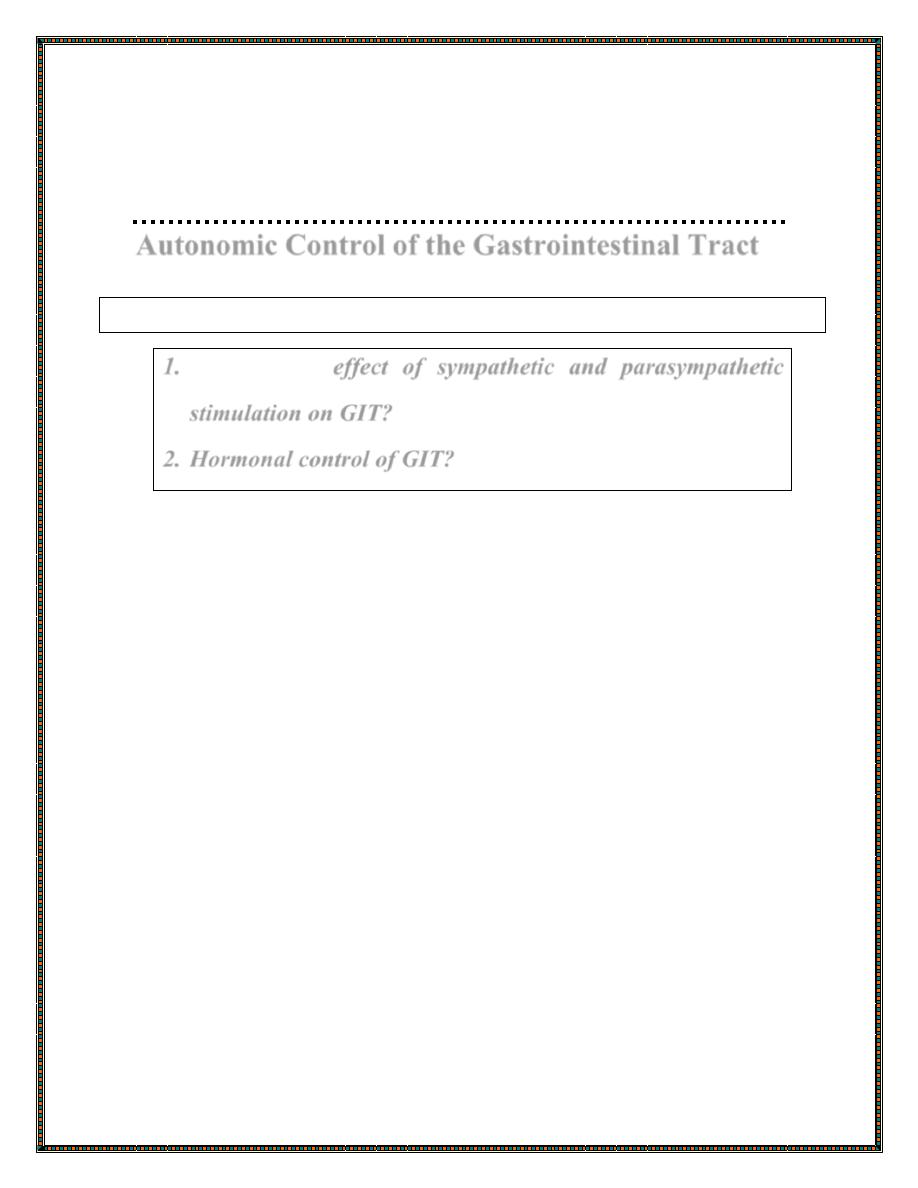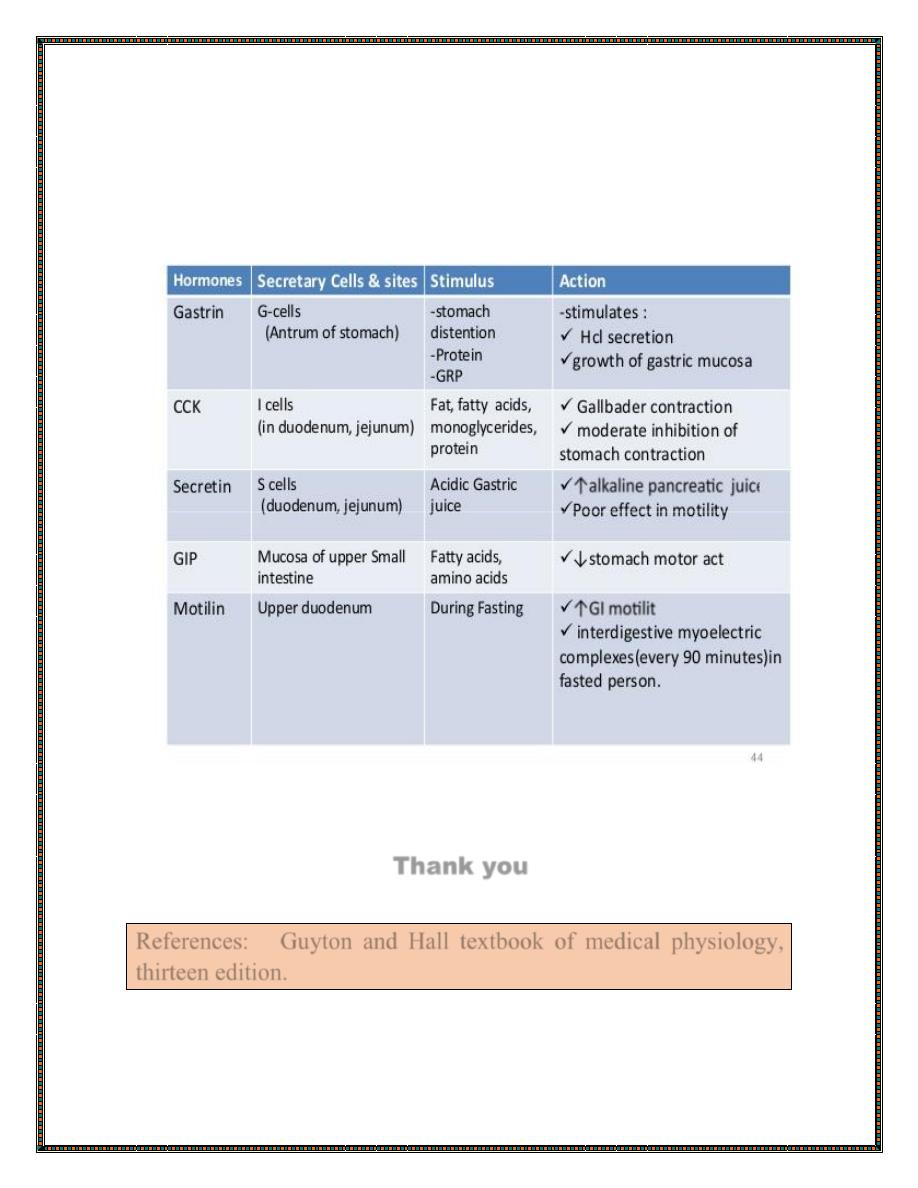
1
بسم هللا الرحمن الرحيم
Lecture -2- Medical Physiology (GIT system)
2
nd
stage Dr. Noor Jawad
Autonomic Control of the Gastrointestinal Tract
Objectives of our lecture:
1. What is the effect of sympathetic and parasympathetic
stimulation on GIT?
2. Hormonal control of GIT?
Parasympathetic Stimulation Increases Activity of the
Enteric Nervous System.
The parasympathetic supply to the gut is divided into cranial and
sacral divisions. Except for a few parasympathetic fibers to the
mouth and pharyngeal regions of the alimentary tract, the cranial
parasympathetic nerve fibers are almost entirely in the vagus nerves.
These fibers provide extensive innervation to the esophagus,
stomach, and pancreas and somewhat less to the intestines down
through the first half of the large intestine. The sacral
parasympathetics originate in the second, third, and fourth sacral
segments of the spinal cord and pass through the pelvic nerves to the
distal half of the large intestine and all the way to the anus.

2
The sigmoidal, rectal, and anal regions are considerably better
supplied with parasympathetic fibers than are the other intestinal
areas.
The postganglionic neurons of the gastrointestinal parasympathetic
system are located mainly in the myenteric and submucosal
plexuses.
Stimulation of these parasympathetic nerves causes general increase
in activity of the entire enteric nervous system, which in turn
enhances activity of most gastrointestinal functions.
Sympathetic Stimulation Usually Inhibits Gastrointestinal
Tract Activity.
The sympathetic fibers to the gastrointestinal tract originate in the
spinal cord between segments T5 and L2. Most of the preganglionic
fibers that innervate the gut, after leaving the cord, enter the
sympathetic chains that lie lateral to the spinal column, and many of
these fibers then pass on through the chains to outlying ganglia such
as to the celiac ganglion and various mesenteric ganglia. Most of the
postganglionic sympathetic neuron bodies are in these ganglia, and
postganglionic fibers then spread through postganglionic
sympathetic nerves to all parts of the gut.
The sympathetics innervate essentially all of the gastrointestinal
tract, rather than being more extensive nearest the oral cavity and

3
anus, as is true of the parasympathetics. The sympathetic nerve
endings secrete mainly norepinephrine. In general, stimulation of
the sympathetic nervous system inhibits activity of the
gastrointestinal tract, causing many effects opposite to those of the
parasympathetic system. It exerts its effects in two ways: (1) to a
slight extent by direct effect of secreted norepinephrine to inhibit
intestinal tract smooth muscle (except the mucosal muscle, which it
excites) and (2) to a major extent by an inhibitory effect of
norepinephrine on the neurons of the entire enteric nervous system.
Strong stimulation of the sympathetic system can inhibit motor
movements of the gut so greatly that this can literally block
movement of food through the gastrointestinal tract.
Afferent Sensory Nerve Fibers From the Gut
Many afferent sensory nerve fibers innervate the gut. Some of the
nerve fibers have their cell bodies in the enteric nervous system and
some have them in the dorsal root ganglia of the spinal cord. These
sensory nerves can be stimulated by (1) irritation of the gut mucosa,
(2) excessive distention of the gut, or (3) the presence of specific
chemical substances in the gut. Signals transmitted through the
fibers can then cause excitation or, under other conditions, inhibition
of intestinal movements or intestinal secretion.

4
In addition, other sensory signals from the gut go all the way to
multiple areas of the spinal cord and even to the brain stem. For
example, 80 percent of the nerve fibers in the vagus nerves are
afferent rather than efferent. These afferent fibers transmit sensory
signals from the gastrointestinal tract into the brain medulla which,
in turn, initiates vagal reflex signals that return to the gastrointestinal
tract to control many of its functions.
Gastrointestinal Reflexes
The anatomical arrangement of the enteric nervous system and its
connections with the sympathetic and parasympathetic systems
support three types of gastrointestinal reflexes that are essential to
gastrointestinal control:
1. local reflexes: Reflexes that are integrated entirely within the gut
wall enteric nervous system. These reflexes include those that
control much gastrointestinal secretion, peristalsis, mixing
contractions, local inhibitory effects, and so forth.
2. Short reflexes : Reflexes from the gut to the prevertebral
sympathetic ganglia and then back to the gastrointestinal tract.
These reflexes transmit signals long distances to other areas of the
gastrointestinal tract, such as signals from the stomach to cause
evacuation of the colon (the gastrocolic reflex), signals from the
colon and small intestine to inhibit stomach motility and stomach

5
secretion (the enterogastric reflexes), and reflexes from the colon to
inhibit emptying of ileal contents into the colon (the colonoileal
reflex).
3. long reflexes: Reflexes from the gut to the spinal cord or brain
stem and then back to the gastrointestinal tract. These reflexes
include especially (1) reflexes from the stomach and duodenum to
the brain stem and back to the stomach—by way of the vagus
nerves— to control gastric motor and secretory activity; (2) pain
reflexes that cause general inhibition of the entire gastrointestinal
tract; and (3) defecation reflexes that travel from the colon and
rectum to the spinal cord and back again to produce the powerful
colonic, rectal, and abdominal contractions required for defecation
(the defecation reflexes)
HORMONAL
CONTROL
OF
GASTROINTESTINAL
MOTILITY
The gastrointestinal hormones are released into the portal circulation
and exert physiological actions on target cells with specific
receptors for the hormone. The effects of the hormones persist even
after all nervous connections between the site of release and the site
of action have been severed.. Most of these same hormones also
affect motility in some parts of the gastrointestinal tract. Although
the motility effects are usually less important than the secretory

6
effects of the hormones, some of the more important motility effects
are described in the following paragraphs.
Gastrin is secreted by the “G” cells of the antrum of the stomach in
response to stimuli associated with ingestion of a meal, such as
distention of the stomach, the products of proteins, and gastrin-
releasing peptide, which is released by the nerves of the gastric
mucosa during vagal stimulation. The primary actions of gastrin are
(1) stimulation of gastric acid secretion and (2) stimulation of
growth of the gastric mucosa.
Cholecystokinin (CCK) is secreted by “I” cells in the mucosa of
the duodenum and jejunum mainly in response to digestive products
of fat, fatty acids, and monoglycerides in the intestinal contents.
This hormone strongly contracts the gallbladder, expelling bile into
the small intestine, where the bile, in turn, plays important roles in
emulsifying fatty substances and allowing them to be digested and
absorbed. CCK also inhibits stomach contraction moderately.
Therefore, at the same time that this hormone causes emptying of
the gallbladder, it also slows the emptying of food from the stomach
to give adequate time for digestion of the fats in the upper intestinal
tract. CCK also inhibits appetite to prevent overeating during meals
by stimulating sensory afferent nerve fibers in the duodenum; these
fibers, in turn, send signals by way of the vagus nerve to inhibit
feeding centers in the brain .

7
Secretin, the first gastrointestinal hormone discovered, is secreted
by the “S” cells in the mucosa of the duodenum in response to acidic
gastric juice emptying into the duodenum from the pylorus of the
stomach. Secretin has a mild effect on motility of the gastrointestinal
tract and acts to promote pancreatic secretion of bicarbonate, which
in turn helps to neutralize the acid in the small intestine.
Glucose-dependent insulinotropic peptide (also called gastric
inhibitory peptide [GIP]) is secreted by the mucosa of the upper
small intestine, mainly in response to fatty acids and amino acids
but to a lesser extent in response to carbohydrate. It has a mild effect
in decreasing motor activity of the stomach and therefore slows
emptying of gastric contents into the duodenum when the upper
small intestine is already overloaded with food product Glucose-
dependent insulinotropic peptide, at blood levels even lower than
those needed to inhibit gastric motility, also stimulates insulin
secretion.
Motilin is secreted by the stomach and upper duodenum during
fasting, and the only known function of this hormone is to increase
gastrointestinal motility. Motilin is released cyclically and
stimulates waves of gastrointestinal motility called interdigestive
myoelectric complexes that move through the stomach and small
intestine every 90 minutes in a person who has fasted. Motilin

8
secretion is inhibited after ingestion of food by mechanisms that are
not fully understood.
Thank you
References: Guyton and Hall textbook of medical physiology,
thirteen edition.
